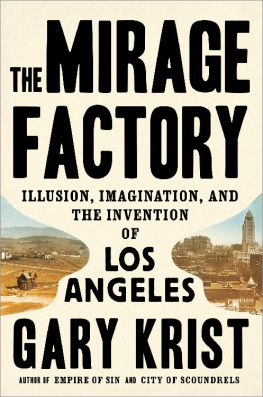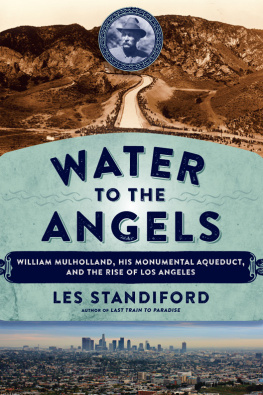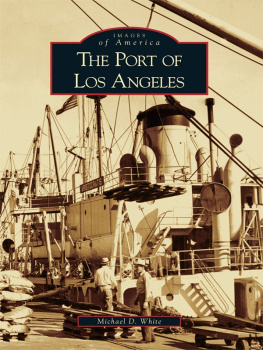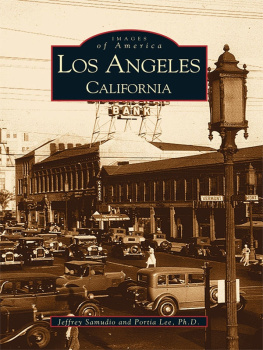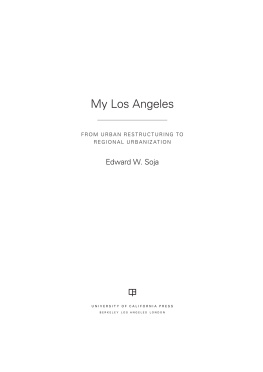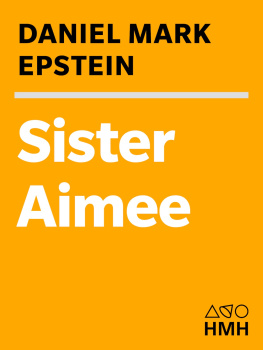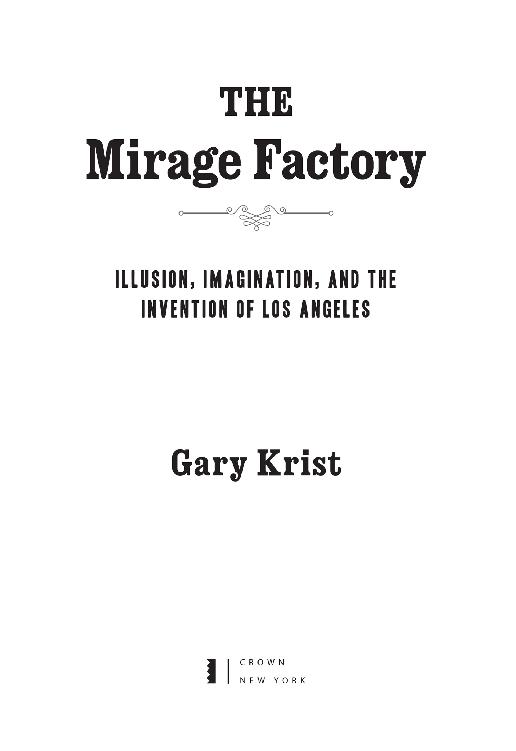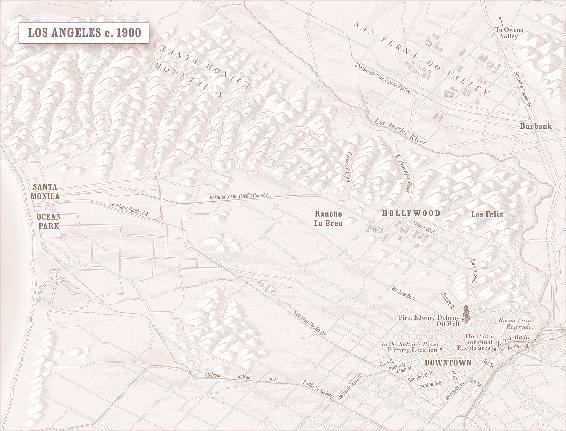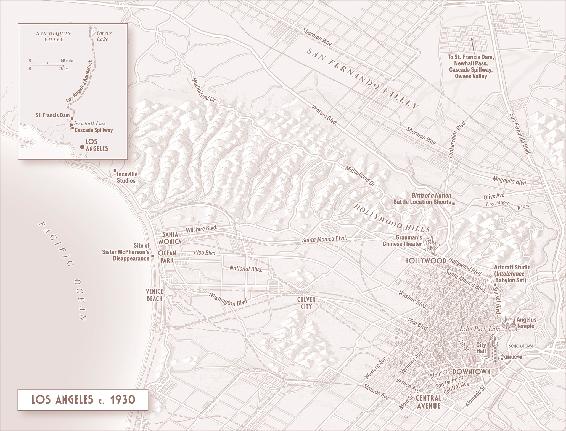ALSO BY GARY KRIST
Empire of Sin
City of Scoundrels
The White Cascade
Extravagance
Chaos Theory
Bad Chemistry
Bone by Bone
The Garden State
Copyright 2018 by Gary Krist
All rights reserved.
Published in the United States by Crown, an imprint of the Crown Publishing Group, a division of Penguin Random House LLC, New York.
crownpublishing.com
CROWN and the Crown colophon are registered trademarks of Penguin Random House LLC.
Library of Congress Cataloging-in-Publication Data is available upon request.
ISBN9780451496386
Ebook ISBN9780451496409
Cover design by Elena Giavaldi
Cover photographs: (left) From the Fletcher photograph collection, courtesy of the California History Room, California State Library, Sacramento, California; (right) USC Libraries. California Historical Society Colletion, 18601960
v5.3.1
a
FOR ELIZABETH
CONTENTS
AUTHORS NOTE
The Mirage Factory is a work of nonfiction, adhering strictly to the historical record and incorporating no invented dialogue or other undocumented re-creations. Unless otherwise attributed, anything between quotation marks is either actual dialogue (as reported by a witness or in a newspaper) or else a citation from a memoir, book, letter, police report, court transcript, or other document, as cited in the endnotes. In some quotations I have, for claritys sake, corrected the original spelling, syntax, word order, or punctuation.
Prologue
Los Angeles, the Invented City
An Echo of Dynamite
LONE PINE, CALIFORNIA
SEPTEMBER 15, 1976
The gatehouse blew shortly after one a.m.a powerful blast that ricocheted off the wall of mountains to the west and resounded across the dark, lonely valley. Another sound followed a moment later. It was less violent but more ominous: the low, rolling, slowly deepening roar of rushing water.
Someone had bombed the Los Angeles Aqueduct. A case of stolen dynamite, fitted out with a blasting cap and a makeshift fuse, had exploded under the Alabama Gatehouse, located about 210 miles north of the city, near the remote town of Lone Pine in the Owens Valley. One of the buildings five spillgatesthick metal doors designed to release excess water from the aqueduct after heavy stormshad been ripped apart, allowing two hundred cubic feet of water per second to pour uselessly down a spillway and out across the parched valley floor. By the time the aqueducts flow could be shut off at another gate some twenty miles north of the breach, over one hundred million gallons would be wastedin one of the driest corners of the country, in the middle of one of the worst droughts in years.
By the time Detective Jim Bilyeu of the Inyo County Sheriffs Department arrived on the scene, a small crowd of Lone Pine residents had gathered near the still-smoking gatehouse. Some were actually applauding the destruction, pounding each other on the back in celebration. Hostility toward the aqueductand toward the distant, insatiably thirsty city that had built itwas widespread across the sparsely populated Owens Valley in 1976, and many locals felt that the L.A. Department of Water and Power (LADWP) had been dealt a well-deserved blow. If I ever find out who bombed the gates, one man allegedly remarked, Ill buy him a steak dinner.
This resentment was not new. Ever since the city built the aqueduct in the early 1900s, tensions between Los Angeles and the Owens Valley had been high. Many in the valley felt that the city had stolen their water, acquiring property and water use rights under false pretenses and then greedily drawing off the flow of the Owens River, allowing L.A. to flourish while the local economy languished. This valleydespite being a Land of Little Rain, as a local writer had famously called itwas at one time an aspiring agricultural region. In the decades around the turn of the century, plentiful water from the Owens River, which gathered the runoff of forty mountain streams in the nearby high Sierra Nevada and channeled it through the otherwise arid region, had sustained livestock and irrigated fields all up and down the hundred-mile-long valley. At its southern end, the river had even broadened out into a large, shallow lake, where local residents could go boating and migrating waterfowl could cavort among the swaying reeds.
Then in 1913, the aqueduct had come, and most of that water had been taken away to nurture the growth of far-off Los Angeles. The people of the Owens Valley had rebelled. Several times during the drought-stricken 1920s, they had responded with dynamite, bombing the aqueduct at various points along its 233-mile path. Relations between city and valley remained poisonous for years. Eventually, though, the parties came to a compromise, declaring an uneasy truce, and the bombings stopped.
Now, decades later, the LADWP was trying to wring yet more water from the valley. To meet the citys needs during this latest drought, they had begun intensive pumping of the valleys groundwater basin, threatening to destroy what was left of the regions vegetation and turning the lower Owens River into nothing more than a dry ditch, winding down the valley to a barren alkaline plain that had once been a lake. No wonder, then, that those people standing around the ruined gatehouse were applauding the bombers. As one valley resident later admitted, Wed all thought about doing something like thatbut they actually hauled off and did it. So weclinked beer bottles in their honor.
Not that this latter-day echo of the 1920s bombing campaign caused Los Angeles much harm. A series of reservoirs much closer to the city held enough water in reserve to ensure that Angelenos suffered no shortages or interruptions in their service. Within a few days of the sabotage, the shattered spillgate was already repaired and the aqueduct was flowing again. County and federal authorities lost no time in ferreting out the perpetrators: two young locals who, after a few beers, had decided that they were fed up with the citys water-grabbing and decided to do something about it. For the bombing of the Alabama Gatehouse, they were eventually indicted, tried, and sentenced to minor jail terms. After doing their time, they were allowed to fade into obscurity.
It was a pattern that had developed over many years: Los Angeles siphoning off resources, industry, and population from elsewhere to satisfy its insatiable desire for growth. The citys leaders had turned this process into something of an art form, getting what was needed to prosper by whatever means necessary. Water was only one of the citys requirements, and the stagnation of the Owens Valley only one of the consequences of this voracity.
The Owens Valley, meanwhile, just grew drier, andas it had for decadesthe great megalopolis to the south just grew bigger and thirstier.
Implausible City
It struck me as an odd thing that here, alone of all the cities in America, there was no plausible answer to the question, Why did a town spring up here and why has it grown so big?

